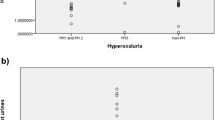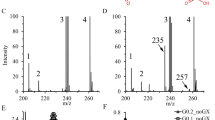Abstract
Background
Primary hyperoxaluria type 3 (PH3) is a recently described cause of childhood renal calculi. It results from mutations in the HOGA1 gene and most cases have been diagnosed after clinical ascertainment, exclusion of other genetic hyperoxalurias and mutation testing. Metabolite testing has not been widely applied but holds promise for the rapid screening and diagnosis of patients who are not specifically suspected to have PH3.
Case-Diagnosis/Treatment
Two cases presented with renal calculi. Urine metabolite testing by tandem mass spectrometry was performed as part of the routine diagnostic work-up for this condition. Both had significantly increased levels of the PH3 urine marker 4-hydroxyglutamate and related metabolites. The diagnosis of PH3 was confirmed by the finding of bi-allelic damaging HOGA1 mutations.
Conclusions
Urine screening by tandem mass spectrometry is a rapid, high-throughput test that can detect PH3 cases that may otherwise not be diagnosed.
Similar content being viewed by others
Abbreviations
- PH3:
-
Primary hyperoxaluria type 3
- HOG:
-
4-Hydroxy-2-oxoglutarate
- 4OHGlu:
-
4-Hydroxyglutamic acid
References
Belostotsky R, Seboun E, Idelson GH, Milliner DS, Becker-Cohen R, Rinat C, Monico CG, Feinstein S, Ben-Shalom E, Magen D, Weissman I, Charon C, Frishberg Y (2010) Mutations in DHDPSL are responsible for primary hyperoxaluria type III. Am J Hum Genet 87:392–399
Monico CG, Rossetti S, Belostotsky R, Cogal AG, Herges RM, Seide BM, Olson JB, Bergstrahl EJ, Williams HJ, Haley WE, Frishberg Y, Milliner DS (2011) Primary hyperoxaluria type III gene HOGA1 (formerly DHDPSL) as a possible risk factor for idiopathic calcium oxalate urolithiasis. Clin J Am Soc Nephrol 6:2289–2295
Belostotsky R, Pitt JJ, Frishberg Y (2012) Primary hyperoxaluria type III—a model for studying perturbations in glyoxylate metabolism. J Mol Med (Berl) 90:1497–1504
Riedel TJ, Knight J, Murray MS, Milliner DS, Holmes RP, Lowther WT (2012) 4-Hydroxy-2-oxoglutarate aldolase inactivity in primary hyperoxaluria type 3 and glyoxylate reductase inhibition. Biochim Biophys Acta 1822:1544–1552
Ben-Shalom E, Frishberg Y (2015) Primary hyperoxalurias: diagnosis and treatment. Pediatr Nephrol 30:1781–1791
Hopp K, Cogal AG, Bergstralh EJ, Seide BM, Olson JB, Meek AM, Lieske JC, Milliner DS, Harris PC, Rare Kidney Stone C (2015) Phenotype-genotype correlations and estimated carrier frequencies of primary hyperoxaluria. J Am Soc Nephrol 26:2559–2570
Allard L, Cochat P, Leclerc AL, Cachat F, Fichtner C, De Souza VC, Garcia CD, Camoin-Schweitzer MC, Macher MA, Acquaviva-Bourdain C, Bacchetta J (2015) Renal function can be impaired in children with primary hyperoxaluria type 3. Pediatr Nephrol 30:1807–1813
Feldkötter M, Wei AZ, Langman CB, Ventzke A, Hoppe B (2014) Urinary hydroxy-oxo-glutarate (HOG) as diagnostic factor for primary hyperoxaluria type 3 [abstract SA-OR087]. Annual Scientific Meeting of the American Society of Nephrology. Journal of the American Society of Nephrology, Philadelphia, USA, p 100A
Pitt JJ, Willis F, Tzanakos N, Belostotsky R, Frishberg Y (2015) 4-hydroxyglutamate is a biomarker for primary hyperoxaluria type 3. JIMD reports 15:1–6
Clifford-Mobley O, Hewitt L, Rumsby G (2016) Simultaneous analysis of urinary metabolites for preliminary identification of primary hyperoxaluria. Ann Clin Biochem 53:485–494
Beck BB, Baasner A, Buescher A, Habbig S, Reintjes N, Kemper MJ, Sikora P, Mache C, Pohl M, Stahl M, Toenshoff B, Pape L, Fehrenbach H, Jacob DE, Grohe B, Wolf MT, Nurnberg G, Yigit G, Salido EC, Hoppe B (2013) Novel findings in patients with primary hyperoxaluria type III and implications for advanced molecular testing strategies. Eur J Hum Genet 21:162–172
Pitt JJ, Eggington M, Kahler SG (2002) Comprehensive screening of urine samples for inborn errors of metabolism by electrospray tandem mass spectrometry. Clin Chem 48:1970–1980
Acknowledgements
We thank Robert Dunlop, Ava Mishra, Kai Mun Hong, Mary Eggington and John Odontiadis for their expert assistance with metabolite screening.
Author information
Authors and Affiliations
Corresponding author
Ethics declarations
Conflicts of interest
The authors declare that they have no conflict of interest.
Rights and permissions
About this article
Cite this article
Greed, L., Willis, F., Johnstone, L. et al. Metabolite diagnosis of primary hyperoxaluria type 3. Pediatr Nephrol 33, 1443–1446 (2018). https://doi.org/10.1007/s00467-018-3967-6
Received:
Revised:
Accepted:
Published:
Issue Date:
DOI: https://doi.org/10.1007/s00467-018-3967-6




